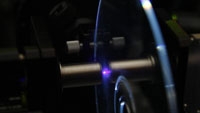General Electric unveils microholographic storage breakthrough

GE Global Research, the technology development arm of General Electric, announced a laboratory breakthrough that dramatically increases the amount of data that can be stored on a single optical disc.
The researchers successfully demonstrated a threshold microholographic storage material that can support 500GB of storage capacity in a standard-sized disc. This is equal to the capacity of 20 single-layer Blu-ray discs, 100 DVDs or the hard drive for a large desktop computer.
Though only a laboratory development at this stage, the new microholographic technology is expected to first impact the video, television and motion pictures industries — all of which need massive amounts of storage. For home video viewers, the breakthrough means that an entire HD movie collection could be stored on a single disc.
Optical storage experts called GE’s announcement a major new advance in archival technology. However, obstacles remain to mass-produce the technology at an affordable cost.
GE’s breakthrough involves holographic storage, an optical process that stores digital data as light patterns in 3-D images. The holograms act as tiny mirrors that reflect the light patterns when a laser shines on them. Each hologram’s recorded data can then be retrieved.
With the potential to pack data far more densely than conventional optical technology, holographic storage is similar, but different than standard DVD or Blu-ray media. Standard media stores information only on the surface of the disc; holographic storage technology uses the entire volume of the disc material.
Although GE’s microholographic storage technology represents a breakthrough in storage capacity, the hardware and formats are so similar to current optical storage technology that the microholographic players will also allow home users to play back their CDs, DVDs and other digital media on the same player.
The professional video industry's #1 source for news, trends and product and tech information. Sign up below.
GE has been working on holographic storage technology for more than six years. The potential for the technology has long been known. The first research papers on the subject were published in the early 1960s. Many advances have been made over the years in the science, optics and applied physics of holographic storage.
This year, InPhase Technologies, a spinoff of Bell Labs of Alcatel-Lucent, plans to introduce a holographic storage system, using $18,000 machines and expensive discs, for specialized markets such as video production and medical imaging.
However, the GE development, using a different approach than past efforts, relies on smaller, simpler holograms. A key to the GE breakthrough was to find the materials and techniques so that smaller holograms could reflect enough light for their data patterns to be detected and retrieved.
The breakthrough was made at the GE laboratory in Niskayuna, NY, north of Albany. The company plans to present its research data and lab results at an optical data storage conference in Orlando next month.
GE predicts the first products using the new technology will be introduced in 2011 or 2012. The cost, it said, will be less than 10 cents a gigabyte and will then fall rapidly.
